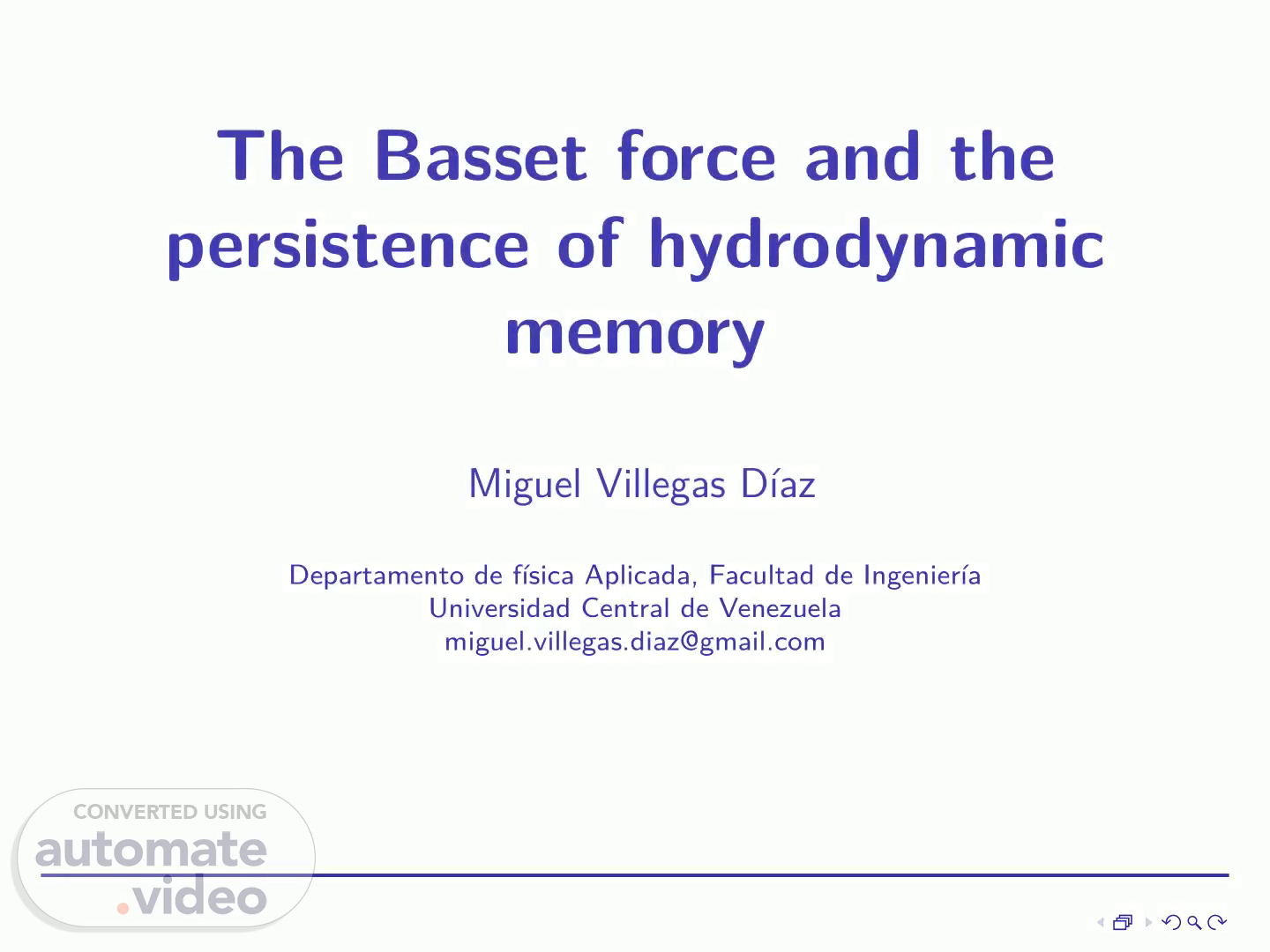
The Basset force and the persistence of hydrodynamic memory
Scene 1 (0s)
[Audio] The Basset force and the persistence of hydrodynamic memory Miguel Villegas Díaz Departamento de física Aplicada, Facultad de Ingeniería Universidad Central de Venezuela miguel.villegas.diaz@gmail.com January 13, 2022 1/11.
Scene 2 (28s)
[Audio] Introduction There has recently been growing interest in the effects of hydrodynamic memory upon the driven transport of micro- and nanoparticles. • Seyler and Pressé Long-time persistence of hydrodynamic memory boosts microparticle transport, Phys. Rev. Res 1, 2019 • Goychuk and Pöschel Hydrodynamic memory can boost enormously driven nonlinear diffusion and transport Phys. Rev. E, 2020 Aplications • Dielectrophoresis of proteins • Magnetic particle imaging ( MPI) 2/11.
Scene 3 (1m 18s)
[Audio] Basset force F(t) = −6 π µ R u(t) − 2 3 π ρ R3 du(t) dt − 6 π µ R ( R2 π ν) 1 2 � t −∞ 1 √ t − τ du(τ) dτ dτ, The Basset history force is a retarded force responsible for the well-known phenomenon of hydrodynamic memory. 3/11.
Scene 4 (2m 4s)
[Audio] The generalized Basset problem The nonuniform motion of a spherical particle in an incompressible fluid du dt + a C 0 Dα t u + u = F(t), a = � 9ρf 2ρp + ρf Γ −1(1 − α), (1) C 0 Dα t u(t) = 1 Γ(α) � t 0 1 (t − τ)1−α dku(τ) dtk dτ, ( 2) where k = 1, 2, 3, .., and k − 1 < α < k, 4/11.
Scene 5 (3m 8s)
[Audio] The generalized Basset problem Seyler and Pressé [1] considered the above equation. They applied a Markovian embedding technique. This method allows us to transform a history-dependent integro differential equation into a numerically tractable system of equations that are local in time. In contrast to [1], we approach Eq. (1) with initial condition u0 = 0 using analytical techniques. Applying the Laplace transform to (1), we get L = 1 (1 + s + a sα ) F(s). (3) where following Mainardi et al. [2] N(s) = 1 (1 + s + a sα ) = 1 − s M(s), M(s) = (1 + a sα−1 ) (1 + s + a sα ) (4) 5/11.
Scene 6 (4m 24s)
[Audio] The generalized Basset problem Eq. (3) can be written as L = � 1 − s M(s) � F(s), (5) taking the inverse Laplace transform gives us u(t) = F(t) + Fc(t), (6) where Fc(t) = −L−1 (7) represents the coupling between the Basset force and the time-dependent driven force 6/11.
Scene 7 (5m 7s)
[Audio] The generalized Basset problem Let us study the case of a driven impulse force F(t) = 1 − H(t − t0) where H(t) is the Heaviside step function, this case was studied in [1], substituting into ( 7), and using the convolution theorem, u(t) = 1−H(t−t0) + � t 0 M(τ) δ(t−τ) dτ − � t 0 M(τ) δ(t−t0−τ) dτ (8) integrating the third and fourth terms of Eq. ( 8) gives us u(t) = 1 − H(t − t0) + M(t − t0) − M(t) ( 9) now, using the result M( 0) = 1, and M(t − t0) > M(t) , we find that the memory effects persist indefinitely, it is worth noticing that, Seyler and Pressé [ 1], were able to compute numerically this fascinating effect of the Basset history force. 7/11.
Scene 8 (6m 32s)
[Audio] The generalized Basset problem Let us consider the case of a driven sinusoidal force of amplitude b and frequency ω, F(t) = b sin(ω t), the particle's velocity will be (using (6)-(7)) u(t) = b sin(ω t) − b L−1 . (10) applying the convolution theorem, we get u(t) = b sin(ω t) − b ω � t 0 M(τ) sin (ω (t − τ)) dτ (11) using the fact that M(t) is a monotonic decreasing function with M(0) = 1, we may see that the second term on the right hand of Eq. (11) decreases as time progresses. Thus, the amplitude of the particle's oscillations increases as time progresses 8/11.
Scene 9 (7m 40s)
[Audio] Results Figure: The plot of the driven step pulse Fa, with ∆t = 1, together with the coupling force given by Fc = −L−1 . . 9/11.
Scene 10 (7m 59s)
[Audio] Results Figure: The plot of the double step pulse Fa, with ∆t = 1, together with the particle's response, the coupling is given by Fc = −L−1 10/11.
Scene 11 (8m 18s)
[Audio] Importance Basset force Memory effects do not just extend the transient relaxation to steady-state but persist indefinitely under a significant parameter regime, implying that the Basset-Bousinessq- Oseen description can be necessary regardless observation timescales. 11/11.
Scene 12 (8m 40s)
[Audio] Sean L. Seyler and Steve Pressé Long-time persistence of hydrodynamic memory boosts microparticle transport, Phys. Rev. Research 1, 032003( R), 2019. Mainardi, P. Pironi, and F. Tampieri, On a generalization of the Basset problem via fractional calculus, Proceedings CANCAM 95( 2), 836– 837 ( 1995). gor Goychuk and Thorsten Pöschel Hydrodynamic memory can boost enormously driven nonlinear diffusion and transport Phys. Rev. E 102, 012139 – Published 17 July 2020 S. Buonocore, M. Sen, and F. Semperlotti, A fractional-order approach for transient creeping flow of spheres, AIP Advances 9, 085323 (2019); doi: 10.1063/ 1.5121241 Miguel Villegas Díaz, On the long-time persistence of hydrodynamic memory, Eur. Phys. J. E ( 2021) 44: 141. 12/11.
Scene 13 (10m 24s)
[Audio] Andrej Krafcik, Peter Babinec, Melania Babincova, Ivan Frollo, Importance of Basset History Force for the Description of Magneti-cally DrivenMotion of Magnetic Particles in Air, MEASUREMENT SCIENCE REVIEW, 20, ( 2020), No. 2, 50– 58 13/11.